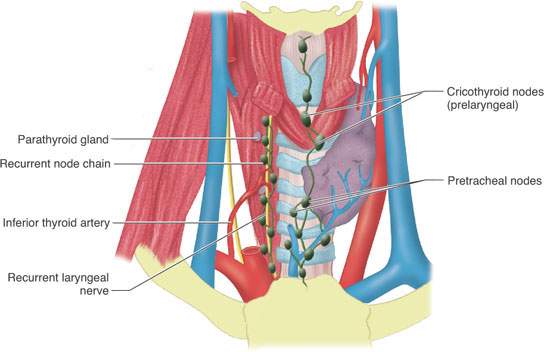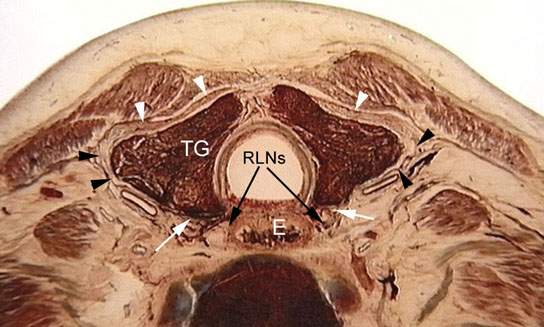THYROID AND PARATHYROID GLANDS: INTRODUCTION
MANCUSOIMAGING APPROACH
Techniques and Relevant Aspects
The thyroid gland is studied essentially in the same manner as the neck with magnetic resonance imaging (MRI), computed tomography (CT), and ultrasound (US). The principles of using these studies are reviewed in Chapter 149. Specific problem-driven protocols for MRI and CT are presented in Appendixes A and B.
The approach with radionuclide studies depends on the specific aim of the examination, although there is a clearly markedly diminishing trend to use radioiodide for the triage in the initial evaluation of mass lesions. This is discussed in more detail in Chapter 5 as well as in Chapter 172.
US, radionuclide studies, CT, magnetic resonance (MR) studies, and at times venous sampling are used in evaluating patients with primary and occasionally secondary hyperparathyroidism.
Pros and Cons
Triage of a low neck mass noted on physical examination as a thyroid mass or nonthyroidal in origin begins with US. Such imaging is also the primary means of following up masses that are clearly of thyroid origin on physical examination or have been discovered incidentally on CT or MRI done for other purposes. CT and MR are reserved for more advanced problem solving.
Radioiodide studies contribute little information to justify their routine use in the evaluation of thyroid masses. Compared to US combined with biopsy, when appropriate, radioiodide studies are relatively nondefinitive and unnecessarily cost additive. They retain a role in the evaluation of functioning metastases in papillary and follicular thyroid cancer. Fluorine-18 2-fluoro-2-deoxy-D-glucose positron emission tomography (FDG-PET) has a niche role to play in the follow-up of patients with thyroid cancer.
Radionuclide studies are typically first line in parathyroid dysfunction. Sestamibi is the preferred agent of choice. US is, however, a reasonable first step in triage, if desired. MRI and CT, as dual-phase CT angiography, may also be used. The use of venous sampling is limited to selected complex cases, usually when the hyperparathyroidism is recurrent.
Controversies
There is significant controversy with regard to how to approach the follow-up of thyroid nodules and other thyroid pathology detected as incidental findings on CT, US, and MRI. Incidental nodules found as being hypermetabolic on FDG-PET studies done for other reasons are usually biopsied under US control unless they are found to be palpable and can be biopsied with the help of US. This is discussed in detail in conjunction with cancer and thyroid nodule evaluation in Chapter 172.
There is an ever decreasing, now minor controversy surrounding the value of parathyroid adenoma localization prior to initial surgery for suspected parathyroid adenoma in cases of primary hyperparathyroidism; this is discussed in Chapter 174.
NORMAL ANATOMY
General Anatomic Description
The thyroid and parathyroid glands are located in the visceral compartment of the low neck. The glands are at the junction of the low neck and thoracic inlet and are a source of pathology that commonly extends into the thoracic inlet and upper mediastinum (Figs. 149.5 and 169.1). Such extension can be simply anatomic, based on developmental factors, or the result of contiguous spread in the related lymphatics. There are also clinically crucial relationships of the thyroid gland to the recurrent laryngeal nerve, larynx, and trachea. The proximity of the thyroid to the esophagus makes that anatomic relationship important in pathologies that arise in either location and can affect structures as well as the recurrent laryngeal nerve and trachea.
The thyroid and parathyroid glands are most closely related to the trachea, being attached to it by a relatively well-developed pretracheal fascia. The pretracheal fascia lies deep to the infrahyoid strap muscles and splits to enclose the thyroid gland, only adhering to the gland at the thyroid isthmus at about the level of the second through fourth tracheal ring (Figs. 169.1 and 169.2). The space formed between the pretracheal fascia and trachea allows for the sliding action necessary during swallowing and neck.
Detailed Description of Specific Areas
Thyroid Gland
The thyroid gland is made up of two roughly symmetric lobes joined together in front of the second, third, and fourth tracheal rings by its isthmus. Each lobe is narrower at the upper pole and broader at the lower pole (Figs. 149.5, 169.1, and 169.3–169.6). The upper pole may reach as high as the lower edge of the thyroid lamina as the lamina lies deep to the infrahyoid strap muscles; however, the tips of the upper pole normally lie adjacent to the mid to lower cricoid level (Fig. 169.1). The lower pole frequently extends to the level of the sixth tracheal ring.

FIGURE 169.1. Anatomic diagrams showing important relationships between the thyroid gland, larynx, trachea, and related neural and vascular structures as well as level 6 lymph nodes.
The thyroid gland lies within a sheath created by the pretracheal fascia (Figs. 149.2C,D and 169.2). The fascia and gland attach to the trachea at the level of the isthmus, causing the gland to move with the trachea during swallowing. The thyroid gland isthmus may be seen connecting the two lobes anterior to the trachea at the level of its second and third rings.
A paramedian pyramidal lobe may develop from the distal thyroglossal duct; this is attached to the medial aspect of one lobe and may extend as far cephalad as the hyoid bone. Accessory thyroid tissue may be found anywhere along the course of the thyroglossal duct or along the path of migration of the thyroid anlage from the branchial arches as discussed in Chapter 170 (Fig. 169.3C).

FIGURE 169.2. Anatomic whole organ section showing the thickening of the pretracheal fascia surrounding the thyroid gland and attaching it to the trachea. The fascia is thick anteriorly (white arrowheads) but thins out laterally and posteriorly (black arrowheads). This fascia holds the thyroid gland and related structures, such as the inferior thyroid vessels and parathyroid glands, in close continuity to one another. The expected position of the parathyroid glands is shown by the white arrows. The position of the recurrent laryngeal nerves (RLNs) is shown by the black arrows. (E, esophagus.)
Stay updated, free articles. Join our Telegram channel

Full access? Get Clinical Tree








